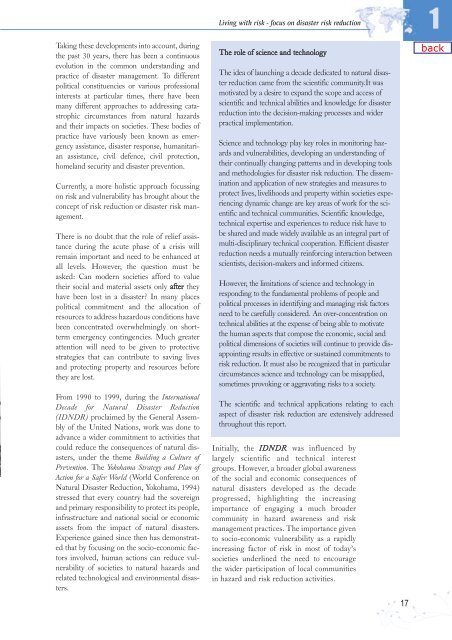Living with Risk. A global review of disaster reduction initiatives
Living with Risk. A global review of disaster reduction initiatives
Living with Risk. A global review of disaster reduction initiatives
You also want an ePaper? Increase the reach of your titles
YUMPU automatically turns print PDFs into web optimized ePapers that Google loves.
Taking these developments into account, during<br />
the past 30 years, there has been a continuous<br />
evolution in the common understanding and<br />
practice <strong>of</strong> <strong>disaster</strong> management. To different<br />
political constituencies or various pr<strong>of</strong>essional<br />
interests at particular times, there have been<br />
many different approaches to addressing catastrophic<br />
circumstances from natural hazards<br />
and their impacts on societies. These bodies <strong>of</strong><br />
practice have variously been known as emergency<br />
assistance, <strong>disaster</strong> response, humanitarian<br />
assistance, civil defence, civil protection,<br />
homeland security and <strong>disaster</strong> prevention.<br />
Currently, a more holistic approach focussing<br />
on risk and vulnerability has brought about the<br />
concept <strong>of</strong> risk <strong>reduction</strong> or <strong>disaster</strong> risk management.<br />
There is no doubt that the role <strong>of</strong> relief assistance<br />
during the acute phase <strong>of</strong> a crisis will<br />
remain important and need to be enhanced at<br />
all levels. However, the question must be<br />
asked: Can modern societies afford to value<br />
their social and material assets only after they<br />
have been lost in a <strong>disaster</strong>? In many places<br />
political commitment and the allocation <strong>of</strong><br />
resources to address hazardous conditions have<br />
been concentrated overwhelmingly on shortterm<br />
emergency contingencies. Much greater<br />
attention will need to be given to protective<br />
strategies that can contribute to saving lives<br />
and protecting property and resources before<br />
they are lost.<br />
From 1990 to 1999, during the International<br />
Decade for Natural Disaster Reduction<br />
(IDNDR) proclaimed by the General Assembly<br />
<strong>of</strong> the United Nations, work was done to<br />
advance a wider commitment to activities that<br />
could reduce the consequences <strong>of</strong> natural <strong>disaster</strong>s,<br />
under the theme Building a Culture <strong>of</strong><br />
Prevention. The Yokohama Strategy and Plan <strong>of</strong><br />
Action for a Safer World (World Conference on<br />
Natural Disaster Reduction, Yokohama, 1994)<br />
stressed that every country had the sovereign<br />
and primary responsibility to protect its people,<br />
infrastructure and national social or economic<br />
assets from the impact <strong>of</strong> natural <strong>disaster</strong>s.<br />
Experience gained since then has demonstrated<br />
that by focusing on the socio-economic factors<br />
involved, human actions can reduce vulnerability<br />
<strong>of</strong> societies to natural hazards and<br />
related technological and environmental <strong>disaster</strong>s.<br />
<strong>Living</strong> <strong>with</strong> risk - focus on <strong>disaster</strong> risk <strong>reduction</strong><br />
The role <strong>of</strong> science and technology<br />
The idea <strong>of</strong> launching a decade dedicated to natural <strong>disaster</strong><br />
<strong>reduction</strong> came from the scientific community.It was<br />
motivated by a desire to expand the scope and access <strong>of</strong><br />
scientific and technical abilities and knowledge for <strong>disaster</strong><br />
<strong>reduction</strong> into the decision-making processes and wider<br />
practical implementation.<br />
Science and technology play key roles in monitoring hazards<br />
and vulnerabilities, developing an understanding <strong>of</strong><br />
their continually changing patterns and in developing tools<br />
and methodologies for <strong>disaster</strong> risk <strong>reduction</strong>. The dissemination<br />
and application <strong>of</strong> new strategies and measures to<br />
protect lives, livelihoods and property <strong>with</strong>in societies experiencing<br />
dynamic change are key areas <strong>of</strong> work for the scientific<br />
and technical communities. Scientific knowledge,<br />
technical expertise and experiences to reduce risk have to<br />
be shared and made widely available as an integral part <strong>of</strong><br />
multi-disciplinary technical cooperation. Efficient <strong>disaster</strong><br />
<strong>reduction</strong> needs a mutually reinforcing interaction between<br />
scientists, decision-makers and informed citizens.<br />
However, the limitations <strong>of</strong> science and technology in<br />
responding to the fundamental problems <strong>of</strong> people and<br />
political processes in identifying and managing risk factors<br />
need to be carefully considered. An over-concentration on<br />
technical abilities at the expense <strong>of</strong> being able to motivate<br />
the human aspects that compose the economic, social and<br />
political dimensions <strong>of</strong> societies will continue to provide disappointing<br />
results in effective or sustained commitments to<br />
risk <strong>reduction</strong>. It must also be recognized that in particular<br />
circumstances science and technology can be misapplied,<br />
sometimes provoking or aggravating risks to a society.<br />
The scientific and technical applications relating to each<br />
aspect <strong>of</strong> <strong>disaster</strong> risk <strong>reduction</strong> are extensively addressed<br />
throughout this report.<br />
Initially, the IDNDR was influenced by<br />
largely scientific and technical interest<br />
groups. However, a broader <strong>global</strong> awareness<br />
<strong>of</strong> the social and economic consequences <strong>of</strong><br />
natural <strong>disaster</strong>s developed as the decade<br />
progressed, highlighting the increasing<br />
importance <strong>of</strong> engaging a much broader<br />
community in hazard awareness and risk<br />
management practices. The importance given<br />
to socio-economic vulnerability as a rapidly<br />
increasing factor <strong>of</strong> risk in most <strong>of</strong> today’s<br />
societies underlined the need to encourage<br />
the wider participation <strong>of</strong> local communities<br />
in hazard and risk <strong>reduction</strong> activities.<br />
17<br />
1

















